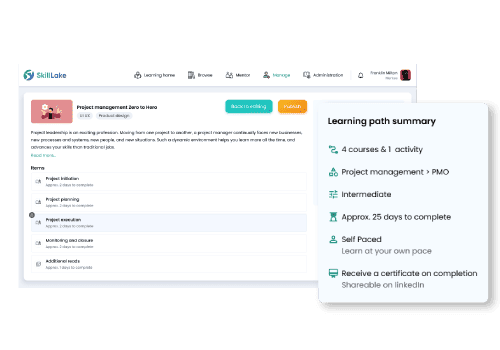Learning Paths: Revolutionizing Employee Development in the Tech Era

The World Economic Forum estimates that, by 2025, 50% of all employees will need reskilling due to adopting new technology. Effectively addressing employee skill gaps is paramount for fostering sustained growth and strengthening workforce competitiveness. Recent insights from Lorman indicate that 80% of U.S. workers believe regular and frequent training surpasses the significance of formal workplace training. The statistics underscore the importance of acknowledging the pivotal role of Learning Management Systems (LMS) in upskilling and empowering employees for continuous learning paths. However, a concerning 33% express dissatisfaction with their current company-provided training, signaling a need for improvements in meeting employee expectations.
One prominent challenge in training is the need for a structured learning journey within traditional LMS. The adoption of Learning Paths emerges as a transformative solution as it offers a meticulously designed roadmap, guiding learners through a coherent and progressive sequence of courses or modules. This not only ensures a more organized and streamlined learning experience but also addresses the issue of employee disengagement, often stemming from difficulties in identifying their learning objectives.
In this blog, we will delve into the intricacies of Learning pathways within LMS, elucidating their role in shaping a comprehensive and impactful approach to employee skill development.
What is a Learning Path?
A Learning Path represents a curated series of courses seamlessly woven together, enabling learners to systematically advance in mastering a specific subject or program. This feature facilitates the simultaneous enrollment of multiple users in various courses, providing a time-saving advantage.
There are distinct learning paths designed for employees and separate learning paths tailored for partners and customers.
A. Learning Paths for Employees
Pathway to learning for employees are curated sequences of training content designed to guide them toward specific skill sets, onboarding, or career goals. These paths can be highly customized to individual needs and career aspirations, ensuring each employee receives the most relevant and impactful learning experience.
B. Learning Paths for Partners and Customers
Learning paths for partners and customers can be a valuable tool to ensure they have the knowledge and skills to leverage your products or services effectively. These paths can help you build stronger relationships, increase customer satisfaction, and drive revenue growth.
Different Types of Learning Paths
Learning Paths are three distinct types—sequenced, learners’ choice, and level. They have been meticulously crafted to cater to specific training objectives.
a) Sequenced Learning Paths
This model entails a carefully structured progression of courses. Each course is a foundational step, preparing learners for the subsequent ones. The emphasis is on creating a well-organized and progressive learning experience.
b) Learners’ Choice Learning Paths
This approach offers a recommended set of courses, yet a rigid sequence does not bind employees. This framework grants individuals the autonomy to select courses based on their proficiency or immediate learning needs, promoting a sense of personalized learning.
c) Level Learning Paths
Demonstrating flexibility, this approach empowers staff to engage with various courses or sessions without a predetermined sequence. It embraces adaptability and caters to diverse learning preferences.
Advantages of Learning Paths
Save Time
Learning paths automatically streamline onboarding, ensuring quick productivity for new team members. It minimizes manual path assignment and tracking efforts, enabling administrators to focus on strategic tasks and enhancing operational efficiency.
Enhancing Efficiency and Knowledge Retention
Learning paths provide a clear and organized structure for training programs, allowing learners to progress through training material logically and efficiently, resulting in a better retention rate.
Increased Engagement
Goal-oriented learning paths provide a sense of purpose and progress, significantly improving learner engagement and motivation compared to traditional training methods.
Learning Paths and eLearning
Learning paths play a crucial role in enhancing the effectiveness of eLearning programs. By carefully curating and sequencing content, learning paths guide learners on a structured journey toward achieving specific learning goals. This integration with Learning Management Systems (LMS) further empowers eLearning by providing a centralized platform for managing and delivering learning content.

Integration with Learning Management Systems (LMS)
Learning Management Systems (LMS) are software applications that manage, deliver, and track online learning content. Learning paths can be seamlessly integrated with LMS, enabling administrators to create and manage the learning path, assign pathway to learning to specific learners or groups, and generate reports.
Sequencing Content
The order in which learning content is presented plays a significant role in knowledge acquisition and retention. Learning paths ensure that content is sequenced logically and progressively, building upon prior knowledge and leading-learners toward mastery of the subject matter. This structured approach promotes effective learning by reducing cognitive overload, building upon prior knowledge, and promoting active learning.
Context and Structure
In traditional eLearning approaches, learners may complete courses but need help to recall key information or apply their knowledge in practical situations. Pathway to learning addresses this issue by providing context and structure, reinforcing learning through repetition, and encouraging self-reflection and assessment.
Best Practices for Implementing Learning Paths
Implementing the learning path is an effective way to guide individuals through a structured and organized educational journey. Here are some best practices to consider:
A. Cloud-based LMS Platforms
Leverage cloud-based Learning Management System (LMS) platforms for seamless accessibility and centralized management of the learning path. It ensures scalability and flexibility to accommodate the evolving needs of the organization.
B. Mobile Learning Features and Bite-sized Information
Integrate mobile learning features to facilitate on-the-go access, catering to the modern workforce. Deliver content in bite-sized formats, promoting better retention and accommodating diverse learning preferences.
C. Establish Criteria for Granting Access to Successive Courses
Define clear criteria for learners to progress through successive courses in a learning path. Implement assessments or milestones to ensure participants have acquired the necessary skills before advancing to the next stage.
Conclusion
Learning paths provide a structured roadmap, guiding employees seamlessly from onboarding to skill mastery, fostering a skilled and motivated workforce. However, choosing an LMS platform that aligns meticulously with your needs is important, prioritizing features like cloud-based accessibility, AI/ML recommendations, immersive AR/VR experiences, SCORM compliance, competency management, and interactive feeds. This careful selection ensures a comprehensive deployment, significantly contributing to sustained workforce growth and success.
A robust LMS solution like Skill Lake helps structure a well-planned, goal-oriented, and accountable learning path to foster a skilled and future-ready workforce. Explore Skill Lake now and discover prominent ways to strengthen your training management efforts. Request a Free Demo now!
Build a culture of continuous learning with Skill Lake’s state-of-the-art people development platform. Give your employees professional training to help them excel in their job roles and propel your business to greater efficiency and success.
Start Today

Aarathy Jayakrishnan
Aarathy is an e-learning professional and enthusiast with a keen understanding of learning and development concepts. She writes insightful content, unraveling the possibilities that e-learning holds, and strives to make education open for all.